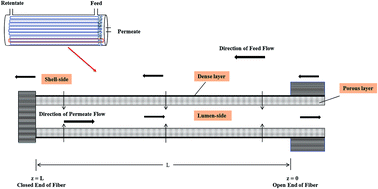Simulation and sensitivity analysis of transport in asymmetric hollow fiber membrane permeators for air separation
Abstract
Development of high performance membranes requires deep insights about the various design, fabrication and operational parameters involved in the process. In the present study, the influence of input parameters such as active fiber length, feed temperature, feed composition and feed pressure is investigated to analyze the efficiency of the mathematical models developed for the separation of O2/N2 mixtures in an asymmetric hollow fiber membrane permeator. In addition, the effect of various non-idealities on the membrane performance are studied, individually. Results reveal that in contrast to pressure, temperature changes have no influential effects on the concentrations of O2 and N2 at permeate and retentate streams. The influence of feed composition on the product purities is more significant compared to active fiber length. Moreover, analysis of non-ideal effects indicates that pressure changes and concentration polarization are the most significant non-idealities among the effects. Results of this investigation can effectively be used for having a comprehensive overview about the impact of influential parameters and non-ideal effects on the membrane performance for O2/N2 separation application.


 Please wait while we load your content...
Please wait while we load your content...